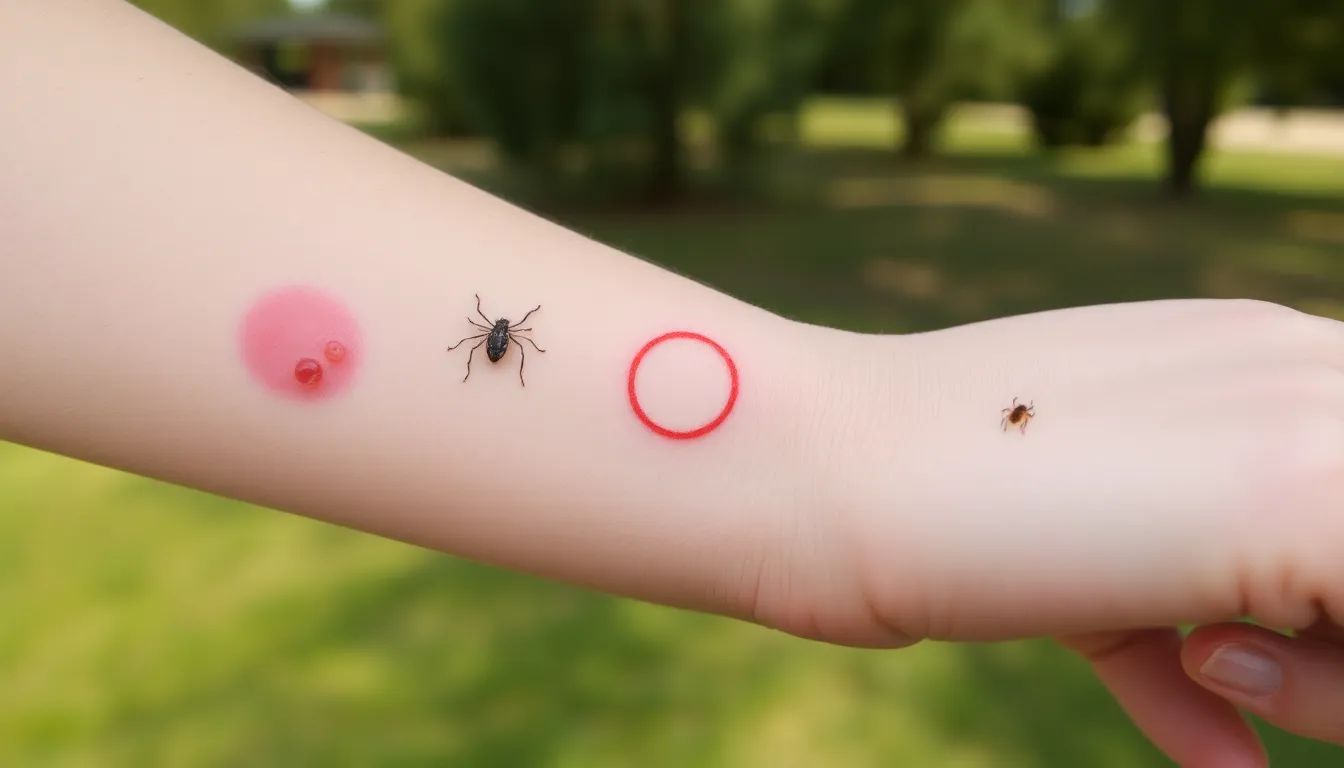Bug bites can turn a pleasant day outdoors into an itchy nightmare. With countless insects buzzing around, it’s essential to recognize the different types of bites and their potential effects. From mosquitoes to spiders, each bite carries its own set of symptoms and risks, making awareness crucial for anyone who enjoys nature.
Understanding the various kinds of bug bites not only helps in identifying the culprits but also aids in determining the best treatment. Some bites may cause minor irritation, while others could lead to serious allergic reactions. By knowing what to look for, individuals can take proactive steps to protect themselves and enjoy their time outside without worry.
Table of Contents
ToggleOverview of Different Kind of Bug Bites
Bug bites vary significantly in appearance, symptoms, and effects. Recognizing different types can help manage discomfort and prevent complications. Here are key types of bug bites:
Mosquito Bites
- Appearance: Round, raised bumps, often reddish and itchy.
- Symptoms: Itching, swelling, and potential skin reaction.
- Risks: Mosquitoes can transmit diseases like West Nile virus and Zika virus.
Tick Bites
- Appearance: Small, sometimes unnoticed until symptoms arise.
- Symptoms: Redness, rash, fatigue depending on tick species.
- Risks: Ticks may carry Lyme disease, Rocky Mountain spotted fever, and other infections.
Flea Bites
- Appearance: Small, red, itchy welts, often in clusters.
- Symptoms: Intense itching and scratching can lead to secondary infections.
- Risks: Fleas may transmit diseases such as typhus and plague.
Spider Bites
- Appearance: Varies by spider species; some may show two puncture marks.
- Symptoms: Pain, redness, and swelling. Severe bites may lead to necrosis.
- Risks: Some spider bites, like those from black widows or brown recluses, can cause serious health issues.
Ant Bites
- Appearance: Red, swollen, and painful bumps.
- Symptoms: Itching and burning pain, dependent on ant type.
- Risks: Fire ants can cause severe allergic reactions and even anaphylaxis.
Bee and Wasp Stings
- Appearance: Red, swollen area with possible venom sac visible.
- Symptoms: Sharp pain, swelling, and itching.
- Risks: Allergic reactions can occur, leading to anaphylaxis in susceptible individuals.
Awareness of these various bug bites aids in timely response and effective treatment, ensuring a more enjoyable outdoor experience.
Common Bug Bites

Various bug bites occur in outdoor settings, displaying distinct characteristics and risks. Understanding these common bites aids in prompt and effective responses.
Mosquito Bites
Mosquito bites typically appear as small, raised, itchy welts on the skin. These bites can cause discomfort and may lead to allergic reactions in some individuals. Mosquitoes can transmit diseases including West Nile virus and Zika virus, emphasizing the need for preventive measures such as insect repellent and protective clothing.
Tick Bites
Tick bites are often characterized by a red, circular rash surrounding a small puncture mark. In some cases, ticks can remain attached for several days, increasing the risk of disease transmission. Lyme disease is a primary concern with tick bites; early identification and treatment are crucial to prevent serious health complications.
Flea Bites
Flea bites generally manifest as small, red, itchy bumps, often clustered in groups. Fleas jump between hosts, which can result in multiple bites in a short timeframe. Intense itching may occur, leading to secondary infections due to scratching. Flea bites can also transmit diseases, making timely treatment essential for relief and prevention.
Less Common Bug Bites
Less common bug bites can still pose significant health risks, requiring prompt recognition and treatment. Understanding these bites helps individuals manage symptoms effectively.
Bed Bug Bites
Bed bug bites often manifest as small, red, itchy welts. These bites typically appear in groups or lines on the skin. The bites can lead to scratching, increasing the risk of secondary infections. Identifying bed bugs involves checking for small, dark stains on bedding or furniture, which are signs of their presence. Treatment focuses on soothing the itching with topical creams and addressing the underlying infestation.
Spider Bites
Spider bites vary based on the species. Some, like the brown recluse and black widow, can result in serious symptoms. Brown recluse bites may cause a red blister that can progress to necrosis, while black widow bites lead to severe pain, muscle cramps, and systemic reactions. Not all spider bites are dangerous; many cause only mild irritation. Identifying the spider species helps determine appropriate treatment, which may include pain management or medical attention for severe cases.
Horsefly Bites
Horsefly bites leave painful, swollen welts and can cause significant discomfort. These bites often result in a burning or stinging sensation. Horseflies are known to transmit pathogens, increasing the risk of infections. Redness and inflammation may persist for several days. Treatment involves applying cool compresses to soothe the area and over-the-counter pain relievers for relief. Keeping the bite clean minimizes the risk of complications.
Identifying Bug Bites
Identifying bug bites involves recognizing their distinct characteristics and associated symptoms. Knowing when to seek medical attention is crucial for effective treatment.
Symptoms to Look For
- Mosquito Bites: Raised, red, itchy welts that may become swollen and inflamed. Symptoms may include local skin irritation and, in some cases, fever or flu-like symptoms if a virus is transmitted.
- Tick Bites: A small, round, red bump often accompanied by a rash that can expand into a larger target-like lesion. Early symptoms may include fever, chills, or fatigue, particularly in cases of Lyme disease.
- Flea Bites: Small, red, itchy bumps usually found in clusters. Intense scratching may lead to secondary infections or allergic reactions, particularly in sensitive individuals.
- Spider Bites: Symptoms vary by species; some cause immediate pain and redness, while others, like those from the brown recluse or black widow, can lead to necrosis, severe pain, or systemic reactions.
- Ant Bites: Fire ant bites create painful, itchy blisters that may become red and swollen. Severe allergic reactions can occur in some individuals, leading to hives or anaphylaxis.
- Bee and Wasp Stings: Immediate sharp pain at the sting site, swelling, and redness. Symptoms of an allergic reaction may include difficulty breathing, swelling of the face or throat, and hives.
When to Seek Medical Attention
- Severe Reactions: Individuals experiencing difficulty breathing, swelling of the face or throat, or rapid heartbeat after a bite should seek emergency care immediately.
- Persistent Symptoms: Unusual symptoms that last longer than a few days, including fever, excessive swelling, or spreading redness, necessitate a medical evaluation.
- Signs of Infection: Increasing redness, warmth, or pus at the bite site may indicate an infection, requiring medical treatment.
- Uncommon Symptoms: Unexplained symptoms, such as severe headaches or joint pain, especially after tick bites, warrant medical attention to rule out conditions like Lyme disease.
Prevention and Treatment
Preventing bug bites is crucial for maintaining a safe outdoor experience. By implementing effective strategies, individuals can minimize their risk of being bitten. Treatment options are available for managing symptoms after a bite occurs.
Preventive Measures
- Wear Protective Clothing: Long sleeves, pants, and closed-toe shoes reduce skin exposure to insects.
- Use Insect Repellent: Apply EPA-approved insect repellents that contain DEET or Picaridin on exposed skin to deter pests.
- Avoid Peak Activity Times: Stay indoors during dawn and dusk when mosquitoes and other biting insects are most active.
- Seal Entry Points: Keep windows and doors closed or screened to prevent indoor insect access.
- Eliminate Standing Water: Regularly empty containers that collect water outdoors to reduce mosquito breeding sites.
- Maintain Yard Hygiene: Trim vegetation and remove debris to reduce resting areas for insects.
Home Remedies for Bug Bites
- Cold Compress: Apply a cold pack to the affected area for 10-15 minutes to reduce swelling and numb the pain.
- Baking Soda Paste: Mix baking soda with water to form a paste, then apply it to the bite for itch relief.
- Aloe Vera: Use pure aloe vera gel for its soothing properties, promoting healing and reducing irritation.
- Honey: Apply a small amount of honey to the bite to leverage its antibacterial properties and relieve itching.
- Oatmeal Bath: Soak in an oatmeal bath to soothe multiple bug bites and relieve itching.
Medical Treatments
- Antihistamines: Over-the-counter antihistamines like diphenhydramine can alleviate itching and swelling caused by insect bites.
- Topical Corticosteroids: Creams such as hydrocortisone reduce inflammation and itching for localized rash relief.
- Prescription Medication: For severe allergic reactions, a healthcare provider may prescribe oral corticosteroids to manage symptoms.
- Tetanus Shot: Individuals who receive a significant wound from a bug bite may require a tetanus booster if their immunization is not current.
- Emergency Care: Seek immediate medical attention for severe cases, such as anaphylaxis, characterized by difficulty breathing, swelling, or hives.
Understanding the various types of bug bites is essential for anyone who enjoys outdoor activities. By recognizing the symptoms and risks associated with different insect bites, individuals can take proactive steps to protect themselves. Awareness of these bites not only aids in timely treatment but also enhances overall outdoor experiences. With effective prevention strategies and knowledge of treatment options, enjoying nature can be both safe and pleasurable. Staying informed ensures that outdoor enthusiasts can navigate the potential challenges posed by bug bites with confidence.


